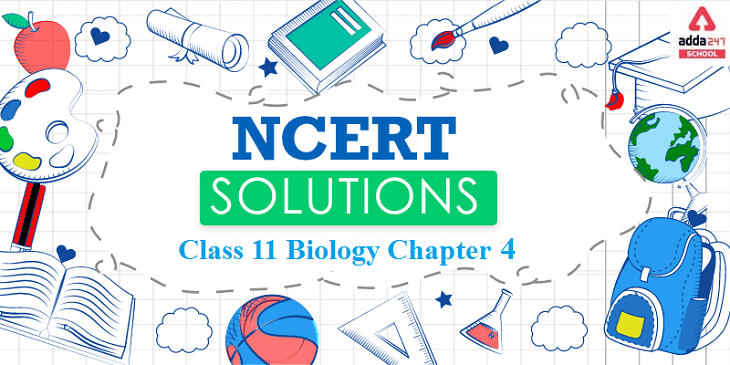Table of Contents
NCERT Solutions Class 11 Biology Chapter 4 in English
Adda 247 provides NCERT Solutions for Class 11 Biology Chapter 4 which is for the students who want to go ahead in life and achieve great marks in their examinations. The NCERT Solutions for Class 11 Biology Chapter 4are provided by the teachers who are experts of their subjects. The solutions are set according to the rules formulated by the NCERT and in the language that can be understood by every student. By these reading the solutions students can build up a strong base easily. The NCERT class 11 Biology solutions covers the chapters 1 to 22 with the important questions and the answers in a detailed way.
Examinations can be threatening for some people, a proper learning of the concepts is the key to crack the examination. Students rely on the solutions of the NCERT provided by Adda 247. The solutions are formulated by the experts of the subjects who have tremendous knowledge in their subjects.
These NCERT Solutions help the students to get familiarized with the textbooks. The students can access the solutions anywhere while browsing the web easily. The solutions are very precise and accurate.
NCERT Solutions for Class 11 Biology Chapter 4 – Animal kingdom
NCERT Solutions for Class 11 Biology Chapter 4 provides information about Animal kingdom. NCERT Solutions for Class 11 Biology Chapter 4 tells about the Animal Kingdom. When you look around, you will observe that there are different animals with different structures and appearances. As over a million species of animals have been discovered until now, the need for classification becomes all the more important. NCERT solutions for class 11 biology chapter 4 animal kingdom contains solutions which comprise of an explanation of all the questions which are based on the kingdom of animals. In solutions of NCERT class 11 biology chapter 4 animal kingdom, you will study the basic fundamental features such as level of organization, symmetry, cell organization, coelom, segmentation, notochord, etc., which have enabled us to broadly classify the animal kingdom. Besides the fundamental features, there are many other distinctive characters which are specific for each class. NCERT solutions for class 11 biology chapter 4 animal kingdom will be also providing you answers related to the questions which are based on the classification of animals.
Key Features of the NCERT Solutions for Class 11 Biology Chapter 4- Animal kingdom
NCERT Solutions for Class 11 Biology Chapter 4 have been answered based on the important information on the question.
- The columns are used wherever necessary.
- Solutions are solved point wise and accurately answered point to point.
Ncert Solution for Class 11 Biology Chapter 4: Important Question
Question 1. What are the difficulties that you would face in classification of animals, if common fundamental features are not taken into account?
Answer:
- There are a number of animal species that display a great variety of life. The common characters are considered for the classification of these animals. If the thing is not done, it is not possible to deal with every living organism separately at individual level. A classification is based on the common fundamental characters to study the diversity properly.
- The interrelationship between the animals will not be traceable.
- The picture of animals at a glance will not be displayed.
.Question 2. If you are given a specimen, what are the steps that you would follow to classify it?
Answer: Various steps to classify a specimen are:
Mode of nutrition: Can be autotrophic, holozoic, saprophytic or parasitic.
- Complexity of body structure: The specimen can be unicellular or multicellular.
- Presence or absence of membrane bound organelles.
- The body symmetry: Bilateral or Radial
- Presence or absence of coelom.
- Phylogenetic relationship
Question 3. How useful is the study of the nature of body cavity and coelom in the classification of animals?
Answer: Coelom is the fluid filled space between the body wall and the gut wall which is lined by the mesoderm on all the sides. The presence or absence of body cavity plays a role in classifying organisms. The animals having fluid filled body cavity between body wall and digestive tract are known as coelomates. For example, Annelids, Molluscs, Arthropods, Echinoderms and chordates. The body of the animals where the body cavity is not lined by mesoderm are pseudocoelomates such as Aschelminthes. The body cavity is not lined by mesoderm and is scattered in between ectoderm and endoderm. The animals where body cavity is present are known as coelomates such as Platyhelminthes.
Question 4. Distinguish between intracellular and extracellular digestion?
Answer:
| Intracellular digestion
Digestion occurs in the food vacuoles in cells.
|
Extracellular digestion
Digestion occurs outside the cells of the lumen of alimentary canal. |
| Lysosomal enzymes are secreted in the food
vacuole. |
The enzymes are secreted in the digestive cavity. |
| Products of digestion diffuse into the cytoplasm by the vacuolar membrane. | The digested materials are absorbed in the blood by gut epithelia. |
| Ingestion occurs by pinocytic vesicles. Example, protozoans, sponges and coelenterates. | Ingestion occurs by mouth. Example, coelenterates to chordates. |
Question 5. What is the difference between direct and indirect development?
Answer:
| Direct development | Indirect development |
| The embryo develops into a mature individual without involving a larval stage. | The sexually immature larva is present. |
| Metamorphosis is absent. | Metamorphosis is present where development into adult occurs. |
| It is seen in fishes, reptiles, birds, mammals. | It is seen in invertebrates and amphibians. |
Question 6. What are the peculiar features that you find in parasitic platyhelminthes?
Answer: The main features are:
- The presence of dorso-ventrally flattened body, known as flatworms.
- Hooks and suckers are present, which help in absorbing nutrients from the host through their
body surface.
- Flame cells are present, which helps in osmoregulation and excretion.
- No respiratory structures.
- Some members like Planaria have high regeneration capacity.
- Example: Tapeworm, Liver fluke.
Question 7. What are the reasons that you can think of for the arthropods to constitute the largest group of the animal kingdom?
Answer: The phylum arthropods constitute about 80% of the total animals in the animal kingdom.
(i) Jointed legs allow more mobility on land.
(ii) Hard exoskeleton which is made up of chitin protects the body.
(iii) Hard exoskeleton reduces water loss from the body and making more adapted to terrestrial conditions.
(iv) Pheromones are exhibited that enable communication.
(v) Well-developed sense organs and nervous system.
Question 8. Water vascular system is the characteristic of which group of the following:
(a) Porifera (b) Ctenophora (c) Echinodermata (d) Chordata
Answer: Echinodermata
Watervascular system is the characteristic of the Echinodermata. The water vascular system helps in functions like locomotion, capturing food, respiration, etc.
Question 9. “All vertebrates are chordates but all chordates are not vertebrates”. Justify the statement.
Answer: All the chordates have a notochord. Chordates include Urochordates, Cephalochordates (both are called protochordates) and vertebrates. In vertebrates notochord is replaced by vertebral column (backbone), but vertebral column is absent in protochordates. Therefore, all vertebrates are chordates but all chordates are not vertebrates.
Question 10. How important is the presence of air bladder in Pisces?
Answer: Air bladder in pisces regulates buoyancy and floats in the water. It prevents them from sinking. The air bladder is present in members of the class Osteichthyes. The animals of Chondrichthyes do not have air bladder and in absence of air bladder, the animals have to swim constantly to avoid sinking.



 KCET Physics Question Paper Answer Key 2...
KCET Physics Question Paper Answer Key 2...
 VITEEE Admit Card 2025 Available at vite...
VITEEE Admit Card 2025 Available at vite...
 UP, MP, CBSE Board Result 2025 Live Upda...
UP, MP, CBSE Board Result 2025 Live Upda...










